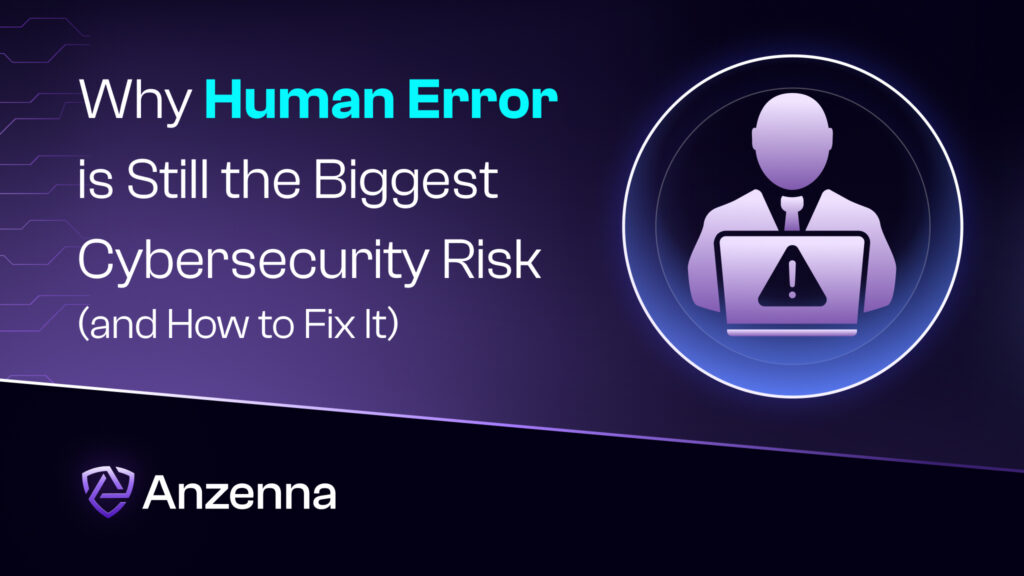If there is one thing that every human can be relied on for, it is making mistakes. To err is only human nature. Despite being aware of this, why is the human element of cybersecurity often overlooked? Accounting for 95% of breaches worldwide, it is a significant issue. Three in four CISOs cited human error as their top cybersecurity risk in 2024. We must realize that cybercriminals don’t succeed through machines. They win through people.
What is Human Error in Computer Security?
Human error in the context of security refers to unintentional actions or inaction by employees or users that lead to a breach. Because human aspects of cyber security encompass a vast range of actions, it becomes quite challenging to address, ranging from downloading malware to failing to use a strong password. The same survey, which cited 75% of CISOs’ primary concern as the human factor in cybersecurity, noted that many of the top causes of data loss could be attributed to human error. A few examples include employee carelessness (42%), malicious insiders (36%), stolen employee credentials (33%), and lost/stolen devices (28%). Work environments have become increasingly complex with the proliferation of various tools, including password managers, two-factor authentication (2FA), biometrics, and other security measures. There is a lot to remember, and it all adds up for the average employee, who will often seek shortcuts. These shortcuts are all it takes for a hacker to identify a vulnerability and exploit it. Even with proper password management and security measures, cybercriminals can still find their way through with social engineering; they don’t need to code, just manipulate humans.
Types of Human Error and Examples
Human cyber risk comes in two different forms: skill-based and decision-based. Skill-based errors are minor mistakes that occur when performing tasks that are familiar and routine. An employee knows the correct course of action, but fails due to a temporary lapse in judgment. Decision-based errors occur when the user makes a faulty decision, which can happen due to various factors, such as lacking the necessary knowledge or failing to recognize that they are making a decision through inaction. Let’s go through some examples.
Skill Based
Misdelivery:
- Misdelivery happens when a user sends something to the wrong recipient, which is relatively easy to do if one isn’t careful. This is the 5th most common cause of security breaches. A prime example is the US government group chat leaks, where a reporter was mistakenly added to a group chat where senior officials were discussing confidential war plans.
Password Problems:
- A whopping 45% of people reuse their main email password on other services. Password problems include writing down passwords on Post-it notes and sticking them on monitors, or sharing them with colleagues. These are everyday actions where people know better, but make careless mistakes.
Physical Security:
- Unauthorized people can easily access confidential information if they gain access to secure premises. For example, leaving sensitive documents unattended for others to find. Tailgating is another concerning phenomenon, where an unauthorized person follows someone closely through a secure door.
Decision Based
Patching:
- When developers detect vulnerabilities in an application, they patch them and send out these updates to users. The problem arises when users delay installations, which can lead to compromises.
Shadow IT:
- Shadow IT involves the use of software, applications, or devices that a company’s IT department hasn’t approved. This could include using Google Drive or downloading a Chrome extension because it is more efficient than the system the company uses, purely out of convenience and not necessarily malicious. However, these tools may have unaccounted security vulnerabilities, and can lead to blind spots for security teams.
Falling for Phishing Scams:
- If an employee is in a rush or not paying close attention, it can be easy to fall for sketchy emails from people claiming to be someone they are not. Scammers understand human behavior in cyber security and are often quite skilled at crafting their emails, whether impersonating a CEO asking for gift cards or a message attached with an “important document.” Unaware employees can easily fall prey to these tricks, potentially leading to compromised information, malware downloads, and other security risks.
Human error can feel like a broad topic, but they are broken down by security leaders into structured categories called insider attack vectors, representing the most common ways insiders put organizations at risk. Industry data reveals the top concerns to be information disclosure (56%), unauthorized data operations (48%), credential and account abuse (47%), security evasion and bypass (45%), and software and code manipulation (44%). Stepping back, these categories directly reflect the errors we just went through, showing how small slip-ups and conscious choices feed into bigger security risks that teams have to manage every day.
Factors that Cause Human Errors in Cyber Security
Human error does not arise out of thin air. There are various human factors of cyber security that contribute to the presence of human error. The simple truth is that if there are more opportunities for things to go wrong, more mistakes will happen. The company environment also plays a key role in the likelihood of human error happening. Human behavior and cybersecurity are closely intertwined, with privacy, posture, and noise level all contributing to a more error-prone environment. A company culture that neglects security only exacerbates the issue. The organization should address a lack of awareness regarding cybersecurity, as employees must be knowledgeable to minimize the risk of human error.
How to Prevent Human Error
Now, we understand the pressing nature of human error. How do we prevent it?
Reduce the Opportunities
More opportunities for error mean more mistakes, so let’s discuss how to reduce these opportunities. One effective way to mitigate human cybersecurity risks is to ensure that users and employees have access only to what they need to perform their roles. Any more and it risks leakage of sensitive information. Another is to effectively manage passwords, using tools like MFA and password management applications. This helps reduce the likelihood of password slip-ups and the implications of reused passwords.
Change Your Culture
Company culture shouldn’t be an afterthought; it plays a significant role in various aspects of a business and human behavior in cybersecurity. Employees should feel comfortable enough to discuss and ask questions in the workplace. Bring up security topics relevant to day-to-day work to keep employees engaged and help them understand how they can contribute to security. If employees or users have security concerns, they should be able to approach you or someone else with knowledge, rather than risk guessing. Reward people who ask questions, and always have someone there to answer them. Posting reminders on how to stay secure is only helpful. The key is to make each person feel like they share responsibility for the company’s security.
Address Lack of Knowledge with Training
Knowledge employees make for a more secure workplace. After all, they make up the “human” in human error. Employees need to be trained on core security topics so they know how to handle situations when they arise. Review past incidents to determine which are most important, and focus on those. Training should be relevant and engaging. Rather than sending out an all-encompassing training module once a year to all employees, consider identifying which employees require specific types of training and target them accordingly. Send out mini training modules monthly to keep topics fresh in their minds at all times, as opposed to doing it annually and then forgetting about them.
Use AI Tools to Overcome Cybersecurity Human Risk
Security professionals can only do so much on their own. After utilizing all the previous strategies, it is beneficial to have support in monitoring user risk to overcome human error. The rise of artificial intelligence has brought with it a plethora of AI tools that are incredibly helpful to practitioners in gaining insight into their company’s risk profile. It has been noted that 87% of global CISOs are seeking to deploy AI-powered capabilities to protect against human error and human-centered cyber threats. With clean dashboards and advanced analytics, they provide insights into cyber security and human factors that are difficult to obtain without specialized support.
The Anzenna Solution
Knowing the benefits of utilizing AI tools to address the human factor in cybersecurity, Anzenna immediately comes to mind. Its various functionalities help address multiple human risks that have been discussed. Anzenna provides insight into each user and assigns them a risk score based on their activity. Security teams can investigate shadow IT, identify if a user has downloaded a risky extension, and take action on the issue through the platform rather than just flagging it. The focus on users’ individual risk scores directly helps security teams monitor behaviors tied to insider attack vectors. Instead of just identifying misdelivery or phishing, it allows for the detection of deeper issues such as software manipulation or policy evasion. Based on the user’s dangerous behavior, such as downloading sensitive files to a personal computer or exposing private API keys to the public domain, specific training modules can be implemented. Rather than sending out a basic training module to every user to complete, this allows organizations to be effective and target those who need it most. This also means more engagement, as users know it is specifically for them and not just another lesson they are being forced to complete. Anzenna’s new copilot enables interaction across users and integrations, allowing users to ask key questions to extract the maximum benefit from the information. The platform provides for the management of access, preventing unauthorized individuals from accessing sensitive information and reducing the risk of data leaks.
Human risk is a significant issue, accounting for 95% of breaches and a top priority for 75% of CISOs. Anzenna directly addresses it, providing security teams with unparalleled insights and, hopefully, some peace of mind.








